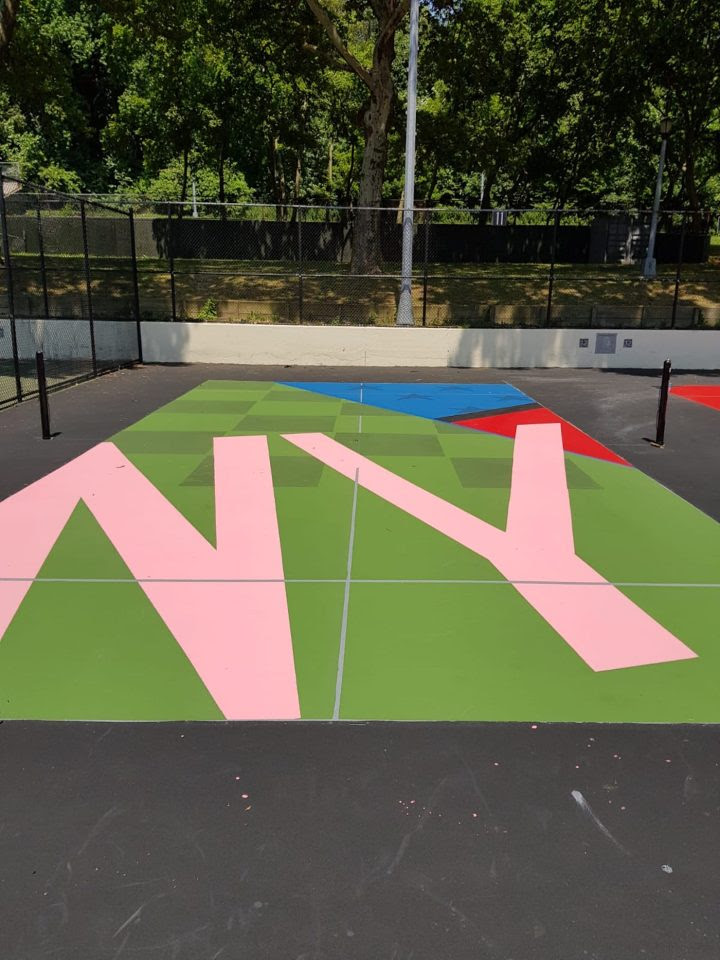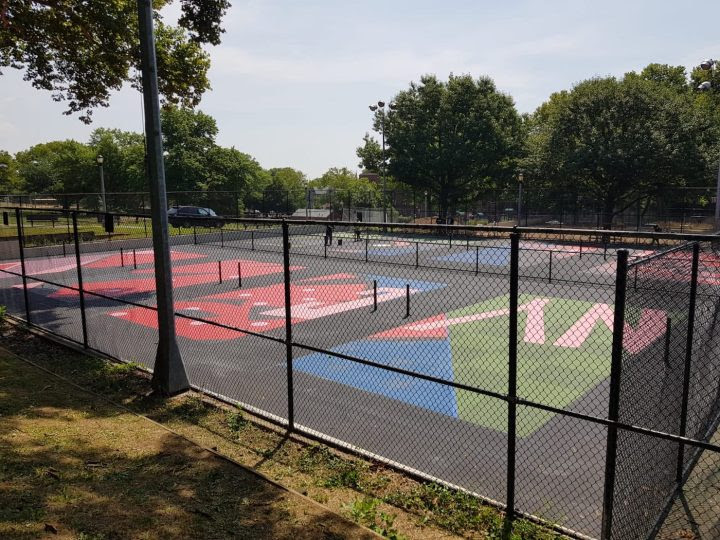USTA Hopes to Re-Energize Tennis with Artist-Designed Courts in Inner Cities
The United States Tennis Association has commissioned artists to design new “Art Courts” in underserved communities.

Tennis court design by Sen2 Figueroa in Brooklyn’s Highland Park (image courtesy the artist)
Looking to spur interest in a sport often derided as an elitist country club pastime, the United States Tennis Association (USTA) has commissioned artists to design new “Art Courts” in underserved communities across the country as a celebration of the U.S. Open’s 50th anniversary. The project is sponsored by a $500,000 donation from Chase Bank.
The tennis court’s dimensions have gone virtually unchanged in the last century. While none of the commissioned artists attempt to redesign the game from scratch, their visual intrusions aim to revitalize how players see the sport. In five cities — Chicago, Cincinnati, Los Angeles, Miami, and New York — local painters have traded in their canvases for over 2,800 square-feet of cement. Each exhibits a vibrant graphical style that beautifies the playing field while attempting to avoid unnecessary distraction.
Naturally, the repainted courts in New York are the loudest of the bunch, exhibiting a technicolor design that appears inspired by Roy Lichtenstein’s comic book pop art. They are the work of Sen2 Figueroa, a self-taught graffiti writer and artist born in Puerto Rico who now lives in Cypress Hills, Brooklyn just blocks from his painting project in the borough’s Highland Park.

Tennis court design by Sen2 Figueroa (image courtesy the artist)
Speaking with The New York Times, Figueroa highlighted just how massive the scope of the USTA’s project was for him. “This was one of the most difficult projects I did in my life; but I liked it a lot,” he said. “I wanted it crispy. I didn’t do it for the money, I wanted to appreciate the details.”
Organizers have noted that the courts will not be used for regulation games, but for public and instructional use. A game of concentration and reflexes, tennis newcomers might benefit from using the iconography of the newly designed courts as target practice. To that end, Figueroa may have been more worried about distracting players than the USTA. Initially, Figueroa revised his drafted for a more muted, minimalist style. Organizers asked the artist to remain true to his pop art proposal, encouraging him to create a new design with bright red lettering and enormous cartoon eyes that cross over two courts.
Cypress Hills is a majority-Hispanic population in Brooklyn where the median household income sits below the national average at $50,348, which is also nearly $12,000 less than the average household income of New York. (It should also be important to note that the average family household size in Cypress Hills is 7.4 people compared to the city’s much smaller average of 2.7.) Understanding these demographics is important to comprehending the importance of the USTA’s public art initiative. Children from low-income households are about half as likely to play a day’s worth of sports than children whose parents earn at least $100,000. And according to data by the Aspen Institute, the gap between young athletes across economic lines grew from 23% to 32 percent in a period of three years from 2013.

Charlie Edmiston’s court designs in Los Angeles’ Jackie Tatum Harvard Park(via USTA Southern California/Facebook)
There’s been an obvious care taken to showcase local talent while supporting underserved communities not traditionally associated with the sport of tennis. In Miami’s Hileah Park, Kiik Create (the artist duo Manoela del Pilar Madera Nadal and David Gray Edgarton) has engendered a more psychedelic spectacle. One court’s dividing net radiates bold, multicolored steaks of light that form two giant hearts. Charlie Edmiston painted the courts in Los Angeles, which are the most minimalist courts of the bunch. Like four panels of one enormous painting, Edmiston has shuffled most of the action to the first court in the series, which contains splashes of green, blue, white, and red. The chaos of this playing field dissipates in the proceeding three, ending in a simple tricolor pattern of navy blue, light blue, and pink.

Tennis court design by Sen2 Figueroa (image courtesy the artist)
While tennis still enjoys a healthy participation number of 17.9 million players, interest in it as a competitive sport has somewhat stalled in recent years. Ratings for this year’s U.S. Open are about 6% lower than they were in 2016. Competitively, the United States also lacks signature players on the global bracket with no Americans ranked in the top ten of the ATP rankings. With some luck, the USTA is hoping that its new “Art Courts” can help reverse its fortunes.



